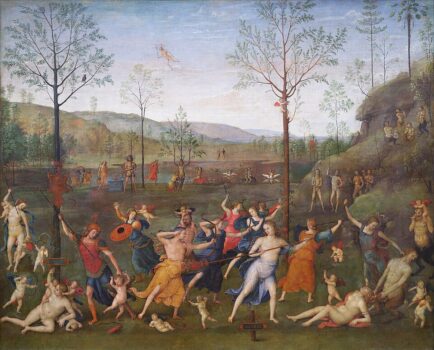The Battle Between Love and Chastity: A Clash of Desire and Virtue on Canvas
In the golden glow of the Italian Renaissance, a time of revived classical ideals, philosophical exploration, and artistic excellence, there existed a vibrant intersection of myth, morality, and beauty. From this unique cultural soil emerged a painting that visually encapsulated a timeless human struggle: The Battle Between Love and Chastity, created by Pietro Perugino, one of the master painters of the Renaissance and a mentor to the great Raphael.
This masterpiece is not merely a depiction of figures in battle; it is a symbolic confrontation between two of humanity’s oldest and most persistent forces, erotic desire and moral restraint. In this singular painting, Perugino did more than illustrate a myth; he staged a cosmic ballet of ideals, rendered with the harmony, elegance, and perspective that defined the High Renaissance.
Who Painted The Battle Between Love and Chastity?
The brush behind this philosophical and artistic feat belonged to Pietro Perugino (circa 1446–1523), an Italian painter of the Umbrian school. Perugino was one of the leading painters of the late 15th century, known for his serene figures, balanced compositions, and an almost divine use of color and space.
Born Pietro Vannucci, he earned the nickname “Perugino” from his hometown of Perugia. His work bridges the linear grace of early Renaissance painting with the compositional mastery that would influence Raphael, his most famous pupil. At the height of his fame, Perugino was commissioned by Isabella d’Este, one of the most powerful female patrons of the Renaissance, to paint this allegorical piece.
What Is Happening in The Battle Between Love and Chastity?
On first glance, the painting bursts with classical figures, draped and undraped, scattered across an ethereal landscape. But a closer examination reveals an intricate allegorical battle between personified virtues and vices.
In the foreground, we witness the intense struggle: figures symbolizing Love, such as Cupid and Venus, are locked in visual and metaphorical combat with figures representing Chastity and Virtue, such as Diana, goddess of the hunt and virginity, and Minerva (Athena), goddess of wisdom and strategic warfare.
Cupid, the mischievous god of desire, appears disarmed and in disarray, while stern, composed female figures representing chastity triumph over lascivious temptations. Diana holds her bow, not to hunt beasts, but to ward off the amorous invaders of virtue. The composition swirls with motion, yet remains balanced, giving the sense of a battle not yet concluded, but leaning toward a moral victory.
In the background, mythological scenes unfold to reinforce the allegory: Apollo chasing Daphne, who transforms into a laurel tree to escape his love; Hercules choosing the path of virtue over vice; and other classical stories where chaste resistance triumphs over sensual pursuit.
The entire scene is set in a luminous, serene landscape, rolling hills, distant architecture, and a tranquil sky, suggesting that even amid the turmoil of internal conflict, there can be grace and order. Perugino invites the viewer into this world, encouraging not just observation, but contemplation.
Why Is The Battle Between Love and Chastity Important?
At its core, The Battle Between Love and Chastity is not just a painting, it is a philosophical and cultural statement. During the Renaissance, artists were more than craftsmen; they were visual philosophers, translating the complex ideas of their time into forms the public could absorb and admire.
This painting reflects the Renaissance ideal of the “virtuous life”, particularly as envisioned by its patron, Isabella d’Este. As a prominent noblewoman and cultural force in Mantua, Isabella sought to surround herself with works that represented intellectual and moral values. The Battle Between Love and Chastity was one of a series of paintings commissioned for her studiolo, a private study meant to house symbols of wisdom, temperance, and learning.
By depicting Chastity victorious over Love, the painting does not merely repress desire but elevates self-control, discipline, and higher reasoning. This echoes Neoplatonic philosophies of the time, which held that earthly love, while powerful, should be transcended in the pursuit of spiritual purity.
Moreover, it was a feminist statement of sorts. In a world where women were often portrayed as objects of desire or moral failing, Isabella flipped the narrative. She commissioned works where women stood as paragons of virtue, guardians of intellect, and spiritual conquerors. In this light, Perugino’s painting becomes both a celebration of chastity and a subtle assertion of feminine strength.
What Type of Art Is The Battle Between Love and Chastity?
Perugino’s painting is a textbook example of Renaissance allegorical art, a genre in which symbolic figures and mythological themes are used to convey moral or philosophical messages.
Stylistically, it embodies the High Renaissance ideals: balanced composition, harmonious proportions, and idealized beauty. Perugino’s figures are classically posed, echoing ancient statuary, while the landscape shows the depth and linear perspective developed during the Renaissance.
The painting also belongs to the genre of humanist art, influenced by the rediscovery of Greco-Roman texts and the Renaissance revival of classical themes. In this genre, art becomes a tool of intellectual inquiry, a canvas where philosophical dilemmas and ideals are debated in visual form.
The work is also part of the mythological-allegorical tradition, where scenes from classical mythology are reinterpreted through the moral lens of Renaissance humanism.
Where Is The Battle Between Love and Chastity Located Today?
Today, The Battle Between Love and Chastity resides in the Musée du Louvre in Paris, one of the most prestigious art museums in the world. It is part of the museum’s rich collection of Italian Renaissance masterpieces and continues to attract scholars and art lovers alike.
Though it was originally intended for Isabella d’Este’s studiolo in Mantua, the painting eventually made its way into the hands of collectors and, through various historical twists, found a permanent home in the Louvre. There, it stands as a testament not only to Perugino’s mastery but also to the enduring relevance of its theme.
A Timeless Human Struggle
At the heart of The Battle Between Love and Chastity is a conflict that has raged within the human soul across centuries. It is the battle between impulse and restraint, desire and discipline, passion and principle. These dualities are not only philosophical or moral, they are deeply personal, making the painting resonate across time and space.
What makes Perugino’s vision so powerful is that he captures this battle not with blood and violence, but with grace, symbolism, and poise. His figures do not scream or struggle, they embody their roles with a serene intensity, making the painting both tranquil and turbulent at once.
It’s also worth noting that Perugino does not demonize Love, nor does he idolize Chastity blindly. Rather, he presents a world where both forces have their beauty and power, but in the Renaissance worldview, it is Chastity, guided by reason and virtue, that must triumph for the soul to ascend.
More Than a Painting
Perugino’s The Battle Between Love and Chastity is far more than pigment on panel. It is a mirror into the ideals, conflicts, and aspirations of an age that shaped the modern world.
It tells the story of a woman who dared to commission works that represented not only beauty, but intellectual depth and moral force. It reveals the mind of an artist capable of turning abstract values into visceral form. And it engages us, centuries later, in a conversation about our own battles, between what we want and what we believe is right.
In every way, the painting fulfills its Renaissance purpose: to educate, to elevate, and to endure.




